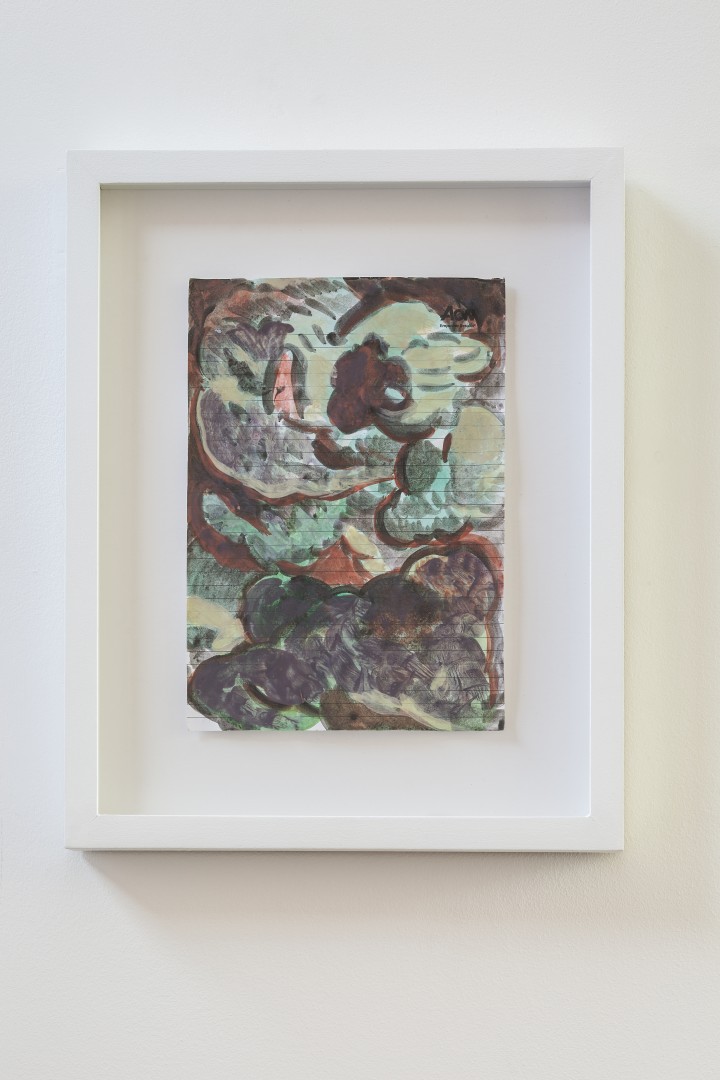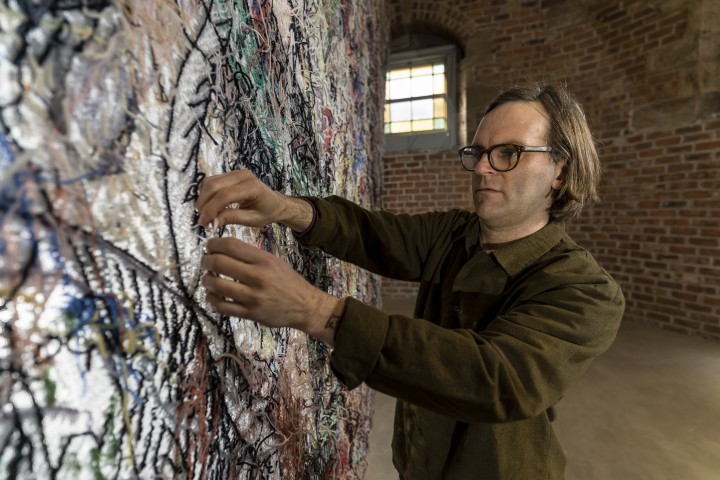Scottish Art News
Latest news
Magazine
News & Press
Publications
Pulling at the Thread
By Greg Thomas, 17.05.2021

Since 2016, London-based American textile artist Christian Newby has been creating large-scale hangings and mobiles using a handheld carpet-tufting gun. These densely worked visual forms are also records of an industrial process thick with cultural and political allusion. Greg Thomas spoke to the artist ahead of a new commission, Boredom>Mischief>Fantasy>Radicalism>Fantasy, for the Collective’s City Dome Exhibition Space in Edinburgh.
“It’s one of those conversations that could just keep on spiralling around itself. It doesn’t take you to any finite point.” Christian Newby has been talking over, around, and through the subject of textile arts for forty-five minutes, in fascinatingly speculative and probing terms which bring to mind his praise for the German-American prose poet Rosmarie Waldrop, an influence on his work: “it’s like she’s still walking through the thought.”
Newby’s compositional process bears a likeness to his speaking style, similarly compelled towards a space beyond easy meaning. Certainly, there is an intuitive visual and sensory beauty to his tapestries, reminiscent of the “all-over” effect which Clement Greenberg saw in abstract expressionism. And Newby’s carpets and hangings are also documents of a creative process whose social and economic connotations – from industrial labour conditions to gendered domestic roles – are central to the artist’s intentions. But it’s as if Newby wants to suspend his works between and beyond these frameworks of meaning, so that they elude and attract interpretation in the same breath, as both object and optic.
_courtesy of the artist.jpg) Christian Newby, Preparatory Collage, 2020. Courtesy of the artist.
Christian Newby, Preparatory Collage, 2020. Courtesy of the artist.
Since 2016, Newby has been working with an industrial carpet-tufting gun to create what he calls “drawings.” The process involves shooting loops of thread at high speed from behind though a woven back-cloth, creating ‘tufts’ of fabric that can be trimmed down to different lengths, allowing effects of volume ranging from plush to threadbare. “There was a moment there where I thought, this is great,” he recalls of purchasing his first gun, after moving from Glasgow to London in 2012. “But all I could do was make carpets. Things didn’t really start to click until 2016 or so. The prototype for what I’m doing now was a show that year in London [Tetracontameron, at Space In Between]. After that I realised I wasn’t interested in carpets, I was interested in the machine.”
This was partly a matter of visceral fascination with the steam-punk aesthetics of his new tool: “there’s these locomotive-age components, moving super-fast, that look like they would chew up your face if you got too close. It’s loud and clattery, and it looks like a drill. But then you see someone like me moving it around and you realise it’s just like a big pencil.” That sense that the gun was a point of access to a compositional approach inbetween artisanship and industrial production was also something of a breakthrough. Newby often uses the language of the body to talk about his interaction with his tapestries – “big bodily gestures, like Jean Dubuffet” “the body is responding” – as if he were attempting to marry human autonomy to factory-line methods.
 Christian Newby at Patricia Fleming Gallery 2021. Image credit: Keith Hunter.
Christian Newby at Patricia Fleming Gallery 2021. Image credit: Keith Hunter.
Not that the work, or the artist, would ever offer a direct polemic on industrial working conditions: “I’m not an expert on labour practices in factories. I went to one in China in 2019 but I felt really uncomfortable walking around there, like some western guy overseeing the thing.” Newby’s medium, the textile-gun, is loaded enough – excuse the pun – to indicate these contexts while obviating the need for queasy messianic gestures: “textiles is a pretty easy universe to operate within because there’s always something profoundly interesting nearby in terms of context...You don’t have to talk about domestic work or factory work or gender issues. Those things are embedded in the process, in the overall history of what textiles represent to humanity.”
Then again, it is also a matter of visual richness, for all that Newby seems to place process over appearances. Discussing the main work in his new show for Collective – described by the gallery as “a large-scale, highly decorative, architectural intervention, a nine metre wide textile ‘wall’ to divide and re-shape the space” – he recalls that, “when I walked into this big open cavity with a dome on top [Calton Hill’s famous City Observatory, now a Collective exhibition space] I just thought, you gotta fill it.”
As this might suggest, the immediate visual and sensory appeal of Newby’s work requires no heavy conceptual framing. The aforementioned work, Flower-Necklace-Cargo-Net, is a huge, multi-coloured woollen chrysalis, suspended from the observatory ceiling at several taut points, as if trapped by giant spiders’ threads. The surface is saturated with free-hand flora and fauna, shells and geometric patterns, all wrought on a jumbo scale with conscious crudity, as if Dubuffet were attempting medieval tapestry. The final layer is an enveloping, cocoon-like fishing-net pattern. There’s that sense of the picture-surface containing a tiny part of an infinite whole which Greenberg found in the New York School: an effect of the regularity and denseness of pattern—notwithstanding some tantalising allusions of depth.
 Christian Newby at Patricia Fleming Gallery 2021. Image credit: Keith Hunter.
Christian Newby at Patricia Fleming Gallery 2021. Image credit: Keith Hunter.
Indeed, when Newby talks about creating his work, you get the sense that a formal reverie takes over at some point, and a kind of horror vacui compels him to pump every segment of backcloth with fibre. He talks memorably of creating Raspberry Jail, one of the works showing in The Drum, The Chime, The Scrape, The Splash, The Jerk, an exhibition running concurrently to his Collective Show at Patricia Fleming in Glasgow. The motifs which pattern the work – raspberries and prison bars – certainly establish an illustrative tension, and this kind of symbolic layer is always planned first. “But when you’re in the studio drawing, you have this very loud machine on, and you get enveloped in a kind of bubble. You’re not thinking about the totality of the thing, even visually, because it’s bigger than you are and you’re very close to it. It becomes a more painterly, abstract process. Content and narrative has now been put on a shelf, and you’re just putting your reds where you want your reds and your greens where you want your greens.”
Just to keep the plates spinning, though, Newby also notes down the thoughts which enter his head during this fugue-like state. These are then translated into pieces of satirical, genre-hopping writing and score which provide an oblique route back towards the political and cultural issues framing his practice. Some of this writing has been shepherded into a pamphlet called Ornaments and Crimes, prepared in the style of a newspaper for visitors to the Collective show. So, our attention is not allowed to settle definitively on any one aspect of the work: object or process, content or context.
In short, Newby’s practice doesn’t lend itself to pithy summary. But his work is no less engrossing for that. As Newby puts it, “there are some things that you can’t explain until you make them...That’s one reason why textiles feels like a really rich place to be.”
 Christian Newby. Photo credit: Aly Wight.
Christian Newby. Photo credit: Aly Wight.
'Boredom>Mischief>Fantasy>Radicalism>Fantasy' opens at Collective on 13th May, running until 29th August. 'The Drum, the chime, the scrape, the splash, the jerk' is open at Patricia Fleming Projects' until the 29th May.




